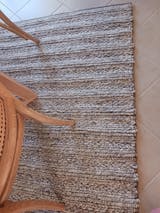Jute is one of the most commonly used natural materials in rug manufacturing. Today we look deeper into what Jute is and why it has become a popular choice of material in rugs.
Jute is an annual crop grown mainly in India and Bangladesh, which has been harvested for centuries. Golden brown and shiny in appearance, jute has a soft but strong and durable texture. These versatile qualities are a result of Jute's unique biology - it consists in part of plant fibres and part wood fibres. Second only to cotton in global production of vegetable fibres, it is an affordable fibre to use in rug manufacturing.
Jute is also an environmentally friendly, natural fibre, with a low carbon footprint compared to other materials, due to many unique qualities:
- Jute has little need for the use of harmful pesticides and fertilisers, and as such the soil it is grown in remains fertile and enriched with micronutrients even after harvesting.
- They convert huge amounts of C02 into oxygen (Jute trees generate 3 times more C02 than most trees during their growth, which is then converted into oxygen).
Jute fibres are very long (often 3 or 4 metres) when harvested, which takes place 4-6 months from planting. Fibres used for production of products such as floor rugs are initially hidden beneath bark, which is soaked for a few days to make the fibres come loose. The fibres are then extracted, washed, and left to dry.
Jute's beneficial qualities when it comes to rugs include it being anti-static, acoustic and thermal insulating, strong, durable and eco-friendly.
Below are a few of our many rugs made from Jute fibre. Please visit the link below for a full list of our rugs that feature Jute (some are Jute only, and others are part Jute and part other materials).
|
|
|
|
|
|








